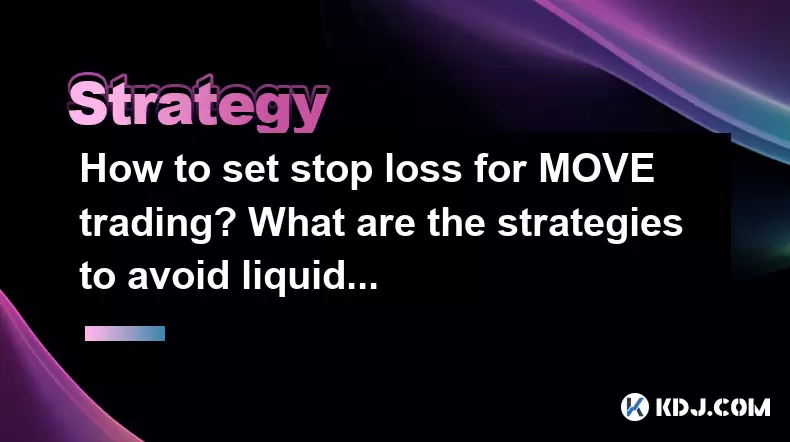-
 bitcoin
bitcoin $122659.385674 USD
0.52% -
 ethereum
ethereum $4484.113342 USD
-0.09% -
 bnb
bnb $1304.229256 USD
-0.85% -
 tether
tether $1.000204 USD
-0.03% -
 xrp
xrp $2.860636 USD
-0.51% -
 solana
solana $227.288799 USD
2.36% -
 usd-coin
usd-coin $0.999805 USD
0.01% -
 dogecoin
dogecoin $0.252837 USD
1.18% -
 tron
tron $0.341149 USD
1.12% -
 cardano
cardano $0.830507 USD
0.33% -
 hyperliquid
hyperliquid $45.792319 USD
0.04% -
 chainlink
chainlink $22.422164 USD
1.55% -
 ethena-usde
ethena-usde $1.000283 USD
0.01% -
 sui
sui $3.511389 USD
0.83% -
 stellar
stellar $0.385276 USD
-0.44%
How to set stop loss for MOVE trading? What are the strategies to avoid liquidation?
Setting a stop loss for MOVE trading and using strategies like proper position sizing and diversification can help manage risk and avoid liquidation effectively.
May 20, 2025 at 09:22 pm

Setting a stop loss for MOVE trading and understanding strategies to avoid liquidation are crucial steps for any trader looking to manage risk effectively. MOVE trading involves trading the native token of the Mover platform, and like any other cryptocurrency trading, it comes with its own set of risks and rewards. In this article, we will explore how to set a stop loss for MOVE trading and delve into various strategies to avoid liquidation.
Understanding Stop Loss in MOVE Trading
A stop loss is an order placed with a broker to sell a security when it reaches a certain price. In the context of MOVE trading, setting a stop loss helps traders limit their losses on a position. The primary goal is to prevent a small loss from becoming a large one, especially in the highly volatile cryptocurrency market.
To set a stop loss for MOVE trading, you need to follow these steps:
- Log into your trading platform: Ensure you are logged into your trading account on the Mover platform or any other platform that supports MOVE trading.
- Navigate to your open positions: Find the section where your current MOVE trades are listed.
- Select the position you want to set a stop loss for: Click on the specific MOVE trade you wish to protect.
- Set the stop loss price: Enter the price at which you want the stop loss to trigger. This price should be below your entry price to limit potential losses.
- Confirm the stop loss order: Review the details and submit the stop loss order.
Types of Stop Loss Orders for MOVE Trading
When setting a stop loss for MOVE trading, you have several options to choose from, each with its own advantages and considerations:
- Standard Stop Loss: This is a basic stop loss order where the trade is automatically sold when the price reaches the specified level.
- Trailing Stop Loss: A trailing stop loss adjusts the stop price at a fixed percent or dollar amount below the market price. This type of stop loss can help lock in profits as the price of MOVE increases.
- Guaranteed Stop Loss: Some platforms offer guaranteed stop losses that ensure your trade will be closed at the exact price you set, regardless of market gaps or slippage.
Strategies to Avoid Liquidation in MOVE Trading
Liquidation occurs when a trader's position is forcibly closed due to insufficient margin to cover potential losses. To avoid liquidation in MOVE trading, consider the following strategies:
- Proper Position Sizing: Always ensure that the size of your MOVE trades is in line with your overall trading capital. Over-leveraging can lead to quick liquidation.
- Use of Margin Wisely: Be cautious with the amount of margin you use. High leverage can amplify both gains and losses, increasing the risk of liquidation.
- Regular Monitoring: Keep a close eye on your MOVE positions. The cryptocurrency market can be highly volatile, and prices can move quickly.
- Diversification: Do not put all your capital into MOVE trading. Diversifying your investments can help mitigate the risk of liquidation.
Implementing Risk Management Tools
Effective risk management is key to avoiding liquidation. Here are some tools and techniques you can implement:
- Risk-Reward Ratio: Before entering a MOVE trade, calculate the potential risk versus the potential reward. A common ratio is 1:2, where you aim to make twice as much as you risk losing.
- Stop Loss and Take Profit Orders: In addition to setting a stop loss, consider setting a take profit order to lock in gains. This can help you exit a trade at a favorable price before the market turns against you.
- Position Sizing Calculator: Use a position sizing calculator to determine the appropriate amount to invest in a MOVE trade based on your account balance and risk tolerance.
Psychological Aspects of Trading MOVE
Trading psychology plays a significant role in managing risk and avoiding liquidation. Here are some psychological tips to keep in mind:
- Emotional Discipline: Stick to your trading plan and do not let emotions drive your decisions. Fear and greed can lead to poor trading choices.
- Patience: Be patient and wait for the right opportunities. Do not chase the market or enter trades out of impatience.
- Acceptance of Losses: Understand that losses are a part of trading. Accept them and move on without letting them affect your future decisions.
Practical Examples of Setting Stop Loss for MOVE Trading
To illustrate how to set a stop loss for MOVE trading, let's consider a practical example:
- Scenario: You buy 100 MOVE tokens at a price of $10 each. You want to limit your potential loss to 5%.
- Calculation: A 5% loss on your entry price of $10 is $0.50. Therefore, you would set your stop loss at $9.50.
- Execution: Follow the steps outlined earlier to set your stop loss at $9.50. If the price of MOVE drops to $9.50, your position will be automatically sold, limiting your loss to 5%.
Frequently Asked Questions
Q1: Can I adjust my stop loss after it is set for MOVE trading?Yes, you can adjust your stop loss order at any time before it is triggered. Most trading platforms allow you to modify the stop loss price to either tighten your risk management or give your trade more room to breathe.
Q2: What should I do if my stop loss is hit and my MOVE position is closed?If your stop loss is hit and your position is closed, take a moment to review the trade. Analyze what went wrong and consider whether the stop loss was set too tight or if the market moved unexpectedly. Use this information to refine your trading strategy for future MOVE trades.
Q3: How does the volatility of MOVE affect stop loss settings?The volatility of MOVE can significantly impact your stop loss settings. In highly volatile markets, you might need to set wider stop losses to avoid being stopped out prematurely. Conversely, in less volatile conditions, you can set tighter stop losses to manage risk more effectively.
Q4: Are there any fees associated with setting a stop loss for MOVE trading?Fees can vary depending on the trading platform. Some platforms charge a fee for placing a stop loss order, while others may include it in their standard trading fees. Always check the fee structure of your trading platform to understand any potential costs associated with using stop loss orders for MOVE trading.
Disclaimer:info@kdj.com
The information provided is not trading advice. kdj.com does not assume any responsibility for any investments made based on the information provided in this article. Cryptocurrencies are highly volatile and it is highly recommended that you invest with caution after thorough research!
If you believe that the content used on this website infringes your copyright, please contact us immediately (info@kdj.com) and we will delete it promptly.
- Cardano, XRP, and DeFi Integration: A Bombshell Development?
- 2025-10-10 08:25:17
- Crypto Presales: LivLive & the Rush for Early Entry in 2025
- 2025-10-10 08:25:17
- Bitcoin Cash, Trust, and Prime Brokers: A New Era of Transparency?
- 2025-10-10 06:45:16
- Ripple's Stablecoin Expansion: Bahrain, Web3, and RLUSD's Big Push
- 2025-10-10 06:25:13
- Memecoin Trader's Success: Riding the Crypto Wave Like a Pro
- 2025-10-10 06:25:13
- Crypto Presales & Massive Gains: Is AlphaPepe the Next Big Meme Coin?
- 2025-10-10 08:30:13
Related knowledge

Practical parameter settings for a Bitcoin multi-timeframe moving average system
Sep 18,2025 at 10:54pm
Optimizing Timeframe Combinations for Bitcoin Trading1. Selecting appropriate timeframes is crucial when building a multi-timeframe moving average sys...

How can I filter out false breakouts in Dogecoin high-frequency trading?
Sep 22,2025 at 01:00am
Understanding False Breakouts in Dogecoin Trading1. A false breakout occurs when Dogecoin's price appears to move beyond a defined support or resistan...

Techniques for identifying tops and bottoms in the Bitcoin on-chain NVT model
Sep 20,2025 at 07:54pm
Understanding the NVT Model in Bitcoin Analysis1. The Network Value to Transactions (NVT) ratio is often described as the 'P/E ratio' of the cryptocur...

What does the surge in open interest in Bitcoincoin futures mean?
Sep 20,2025 at 11:18pm
Understanding the Surge in Dogecoin Futures Open Interest1. A surge in open interest within Dogecoin futures indicates a growing number of active cont...

How can I use the Ethereum USDT premium to gauge market sentiment?
Sep 18,2025 at 11:55pm
Understanding the Ethereum USDT Premium1. The Ethereum USDT premium refers to the price difference between USDT (Tether) traded on Ethereum-based plat...

What should I do if Ethereum staking yields decline?
Sep 20,2025 at 06:18am
Understanding the Causes Behind Declining Ethereum Staking Yields1. The Ethereum network transitioned to a proof-of-stake consensus mechanism with the...

Practical parameter settings for a Bitcoin multi-timeframe moving average system
Sep 18,2025 at 10:54pm
Optimizing Timeframe Combinations for Bitcoin Trading1. Selecting appropriate timeframes is crucial when building a multi-timeframe moving average sys...

How can I filter out false breakouts in Dogecoin high-frequency trading?
Sep 22,2025 at 01:00am
Understanding False Breakouts in Dogecoin Trading1. A false breakout occurs when Dogecoin's price appears to move beyond a defined support or resistan...

Techniques for identifying tops and bottoms in the Bitcoin on-chain NVT model
Sep 20,2025 at 07:54pm
Understanding the NVT Model in Bitcoin Analysis1. The Network Value to Transactions (NVT) ratio is often described as the 'P/E ratio' of the cryptocur...

What does the surge in open interest in Bitcoincoin futures mean?
Sep 20,2025 at 11:18pm
Understanding the Surge in Dogecoin Futures Open Interest1. A surge in open interest within Dogecoin futures indicates a growing number of active cont...

How can I use the Ethereum USDT premium to gauge market sentiment?
Sep 18,2025 at 11:55pm
Understanding the Ethereum USDT Premium1. The Ethereum USDT premium refers to the price difference between USDT (Tether) traded on Ethereum-based plat...

What should I do if Ethereum staking yields decline?
Sep 20,2025 at 06:18am
Understanding the Causes Behind Declining Ethereum Staking Yields1. The Ethereum network transitioned to a proof-of-stake consensus mechanism with the...
See all articles


























![🚨IS VECHAIN (VET) A DEAD COIN ?? PRICE ANALYSIS [GET READY NOW] 🚨IS VECHAIN (VET) A DEAD COIN ?? PRICE ANALYSIS [GET READY NOW]](/uploads/2025/10/09/cryptocurrencies-news/videos/vechain-vet-dead-coin-price-analysis-ready/68e7b200b067b_image_500_375.webp)















































